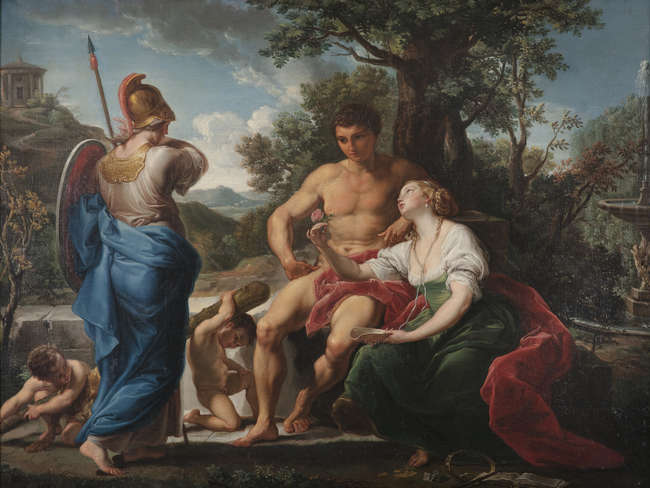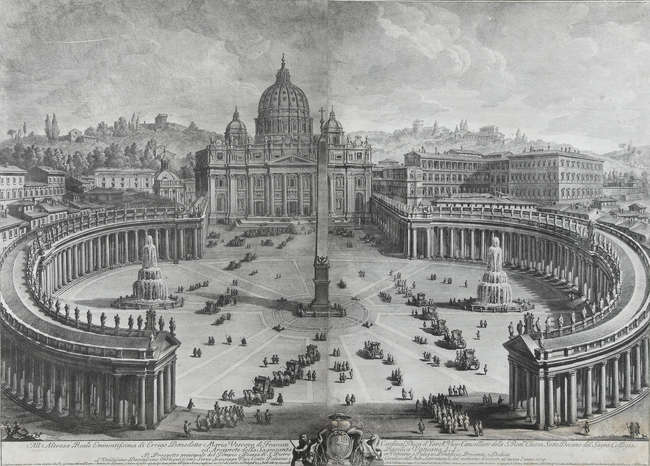ROMAN RUINS AND ANTIQUITIES -- Circle of Giulio ROMANO (1499-1546). An album of original drawings of Roman ruins and antiquities. [Mid-16th century]. 2° (547 x 380mm). 145 leaves (including 37 blanks), each leaf with ruled brown ink border recto and verso, the folio number in red ink at the upper right of each recto. 106 LEAVES OF ORIGINAL DRAWINGS in black chalk, pen and brown ink, brown wash, some outlines incised, rectos only (except the two final drawings: two double-page, including one with an additional fold-out section). (Some light unobtrusive dampstaining.) Paper : watermarks from four distinct paper stocks. 1) crossed arrows (cf. Briquet 6302, Verona 1545); 2) grapes (cf. Briquet 13065, Lyon 1485-1530); 3) hand surmounted by a fleur-de-lys (similar to Briquet 11424, Troyes 1502-8); 4) ladder in a shield surmounted by a star (cf. Briquet 5927, Salzburg 1523). Binding : 18th-century diced russia, covers with decorative border of fillets, a simple roll and a decorative inner section built up from a repeat pattern of small tools (including a small flower head and volutes) alternating with a large fleur-de-lys, enclosing the large centrally-placed blocked arms of Louis XIV [Olivier 2494.fer 7], spine in ten compartments with raised bands, black morocco lettering-piece in the second, the others with repeat decoration of a large fleur-de-lys with smaller fleur-de-lys at the four corners, the plain pastedowns mounted with the gilt-bordered and lettered brown calf roundels from the covers of an earlier 16th-century binding, lettered: AEDI FICORUM ANTIQUAE UR BIS MONUMEN TA QUAEDAM E RUINIS EX CERPTA and STRU CTURARUM URBIS PRISCA RUM EXEMP[LA]RI A FRAGMENTO RUM ERUTA EX RUINIS, g.e. (spine chipped at head and foot, joints rubbed and slightly split). Provenance : LOUIS XIV, King of France (1638-1715, binding, red ink 'Bibliothecae Regiae' stamp on first leaf, and f.152); Marquis of Cholmondeley (Cholmondeley Castle bookplate). The present album was probably drawn by an Italian artist in France for the French court around 1570, half of the leaves of the album are of French origina that at a time when French paper was used very locally. The Draughtsmanship of some of the figures such as these on the Tomb of Caecilia Metella is close to that used by artists working with Giulio Romano in Mantua in the middle of the 16th century. A number of these artists, such as Primaticcio, later moved to France to work for Francis I at Fontainbleau, thus following the exapmples of Leonardo da Vinci and Rosso. The art of the French court remained very influenced by Italian artists up to the end of the 16th century, though another important influence in the second half of the 16th century was that of Flemish art, especially in landscape painting. Indeed, some of the naturalistic details in the present album such as the foliage overgrowing the buildings betray such an ascendency. Another indication of the French origins of the album is the intricate pattern designs of leaves 11 and 12 which are based on Leonardo's workshop prints (P. Jean-Richard, Ornemantistes du XVe au XVII siècle , exhib. cat., Musée du Louvre, Paris, 1987, nos.145-6, illustrated) that were to be used in the binding decorations in 16th-century France. The incision of the outlines on most of the drawings indicates that the draughtsman copied his compositions from earlier views. One of the possible sources for the first part of the album, the architectural details, in the Master of 1515's series of architectural prints which mostly show entablatures of different orders (illustrated Bartsch, 13, 23-36). A drawing of comparable handling of a Roman Tomb with its Ground Plan is in the Thomas Ashby collection in the Vatican Library, R. Keaveney, Views of Rome , New York, 1988, no.65, illustrated. The latter drawing is probably cut from a 16th-century album of Roman vies similar to the present one. The album remained the property of the French crown until the first part of t
ROMAN RUINS AND ANTIQUITIES -- Circle of Giulio ROMANO (1499-1546). An album of original drawings of Roman ruins and antiquities. [Mid-16th century]. 2° (547 x 380mm). 145 leaves (including 37 blanks), each leaf with ruled brown ink border recto and verso, the folio number in red ink at the upper right of each recto. 106 LEAVES OF ORIGINAL DRAWINGS in black chalk, pen and brown ink, brown wash, some outlines incised, rectos only (except the two final drawings: two double-page, including one with an additional fold-out section). (Some light unobtrusive dampstaining.) Paper : watermarks from four distinct paper stocks. 1) crossed arrows (cf. Briquet 6302, Verona 1545); 2) grapes (cf. Briquet 13065, Lyon 1485-1530); 3) hand surmounted by a fleur-de-lys (similar to Briquet 11424, Troyes 1502-8); 4) ladder in a shield surmounted by a star (cf. Briquet 5927, Salzburg 1523). Binding : 18th-century diced russia, covers with decorative border of fillets, a simple roll and a decorative inner section built up from a repeat pattern of small tools (including a small flower head and volutes) alternating with a large fleur-de-lys, enclosing the large centrally-placed blocked arms of Louis XIV [Olivier 2494.fer 7], spine in ten compartments with raised bands, black morocco lettering-piece in the second, the others with repeat decoration of a large fleur-de-lys with smaller fleur-de-lys at the four corners, the plain pastedowns mounted with the gilt-bordered and lettered brown calf roundels from the covers of an earlier 16th-century binding, lettered: AEDI FICORUM ANTIQUAE UR BIS MONUMEN TA QUAEDAM E RUINIS EX CERPTA and STRU CTURARUM URBIS PRISCA RUM EXEMP[LA]RI A FRAGMENTO RUM ERUTA EX RUINIS, g.e. (spine chipped at head and foot, joints rubbed and slightly split). Provenance : LOUIS XIV, King of France (1638-1715, binding, red ink 'Bibliothecae Regiae' stamp on first leaf, and f.152); Marquis of Cholmondeley (Cholmondeley Castle bookplate). The present album was probably drawn by an Italian artist in France for the French court around 1570, half of the leaves of the album are of French origina that at a time when French paper was used very locally. The Draughtsmanship of some of the figures such as these on the Tomb of Caecilia Metella is close to that used by artists working with Giulio Romano in Mantua in the middle of the 16th century. A number of these artists, such as Primaticcio, later moved to France to work for Francis I at Fontainbleau, thus following the exapmples of Leonardo da Vinci and Rosso. The art of the French court remained very influenced by Italian artists up to the end of the 16th century, though another important influence in the second half of the 16th century was that of Flemish art, especially in landscape painting. Indeed, some of the naturalistic details in the present album such as the foliage overgrowing the buildings betray such an ascendency. Another indication of the French origins of the album is the intricate pattern designs of leaves 11 and 12 which are based on Leonardo's workshop prints (P. Jean-Richard, Ornemantistes du XVe au XVII siècle , exhib. cat., Musée du Louvre, Paris, 1987, nos.145-6, illustrated) that were to be used in the binding decorations in 16th-century France. The incision of the outlines on most of the drawings indicates that the draughtsman copied his compositions from earlier views. One of the possible sources for the first part of the album, the architectural details, in the Master of 1515's series of architectural prints which mostly show entablatures of different orders (illustrated Bartsch, 13, 23-36). A drawing of comparable handling of a Roman Tomb with its Ground Plan is in the Thomas Ashby collection in the Vatican Library, R. Keaveney, Views of Rome , New York, 1988, no.65, illustrated. The latter drawing is probably cut from a 16th-century album of Roman vies similar to the present one. The album remained the property of the French crown until the first part of t








.jpg)
.jpg)
.jpg)
Testen Sie LotSearch und seine Premium-Features 7 Tage - ohne Kosten!
Lassen Sie sich automatisch über neue Objekte in kommenden Auktionen benachrichtigen.
Suchauftrag anlegen